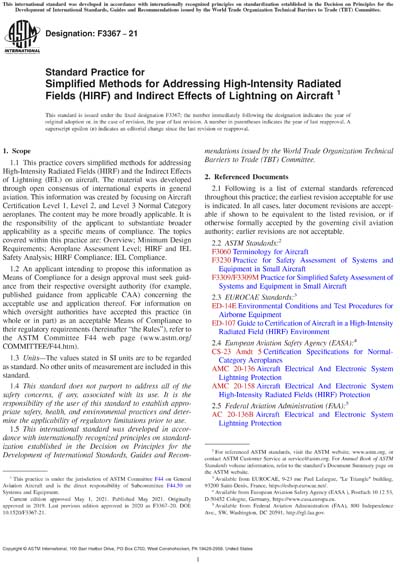Historical
ASTM F3367-21
Standard Practice for Simplified Methods for Addressing High-Intensity Radiated Fields (HIRF) and Indirect Effects of Lightning on Aircraft
1.1 This practice covers simplified methods for addressing High-Intensity Radiated Fields (HIRF) and the Indirect Effects of Lightning (IEL) on aircraft. The material was developed through open consensus of international experts in general aviation. This information was created by focusing on Aircraft Certification Level 1, Level 2, and Level 3 Normal Category aeroplanes. The content may be more broadly applicable. It is the responsibility of the applicant to substantiate broader applicability as a specific means of compliance. The topics covered within this practice are: Overview; Minimum Design Requirements; Aeroplane Assessment Level; HIRF and IEL Safety Analysis; HIRF Compliance; IEL Compliance.
1.2 An applicant intending to propose this information as Means of Compliance for a design approval must seek guidance from their respective oversight authority (for example, published guidance from applicable CAA) concerning the acceptable use and application thereof. For information on which oversight authorities have accepted this practice (in whole or in part) as an acceptable Means of Compliance to their regulatory requirements (hereinafter “the Rulesâ€), refer to the ASTM Committee F44 web page (www.astm.org/COMMITTEE/F44.htm).
1.3 Units—The values stated in SI units are to be regarded as standard. No other units of measurement are included in this standard.
1.4 This standard does not purport to address all of the safety concerns, if any, associated with its use. It is the responsibility of the user of this standard to establish appropriate safety, health, and environmental practices and determine the applicability of regulatory limitations prior to use.
1.5 This international standard was developed in accordance with internationally recognized principles on standardization established in the Decision on Principles for the Development of International Standards, Guides and Recommendations issued by the World Trade Organization Technical Barriers to Trade (TBT) Committee.
Content Provider
ASTM International [astm]






